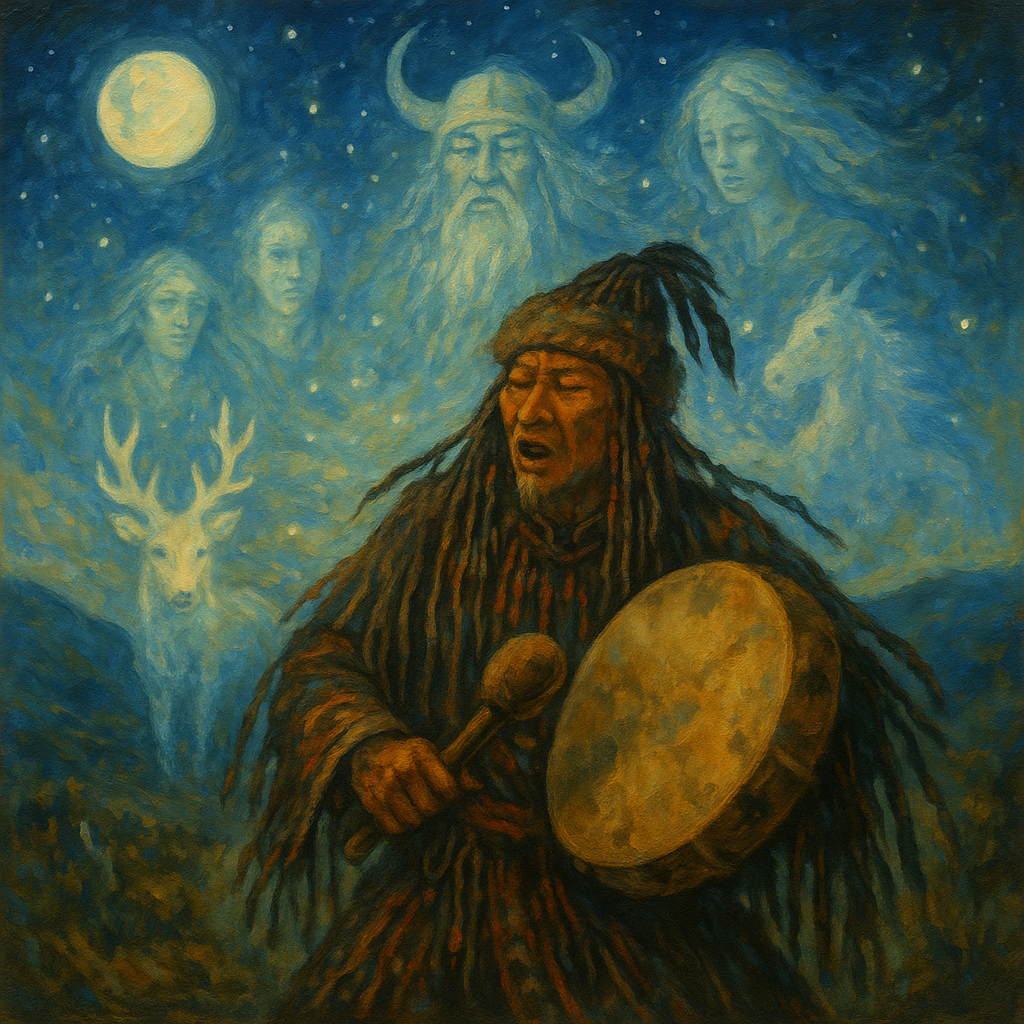Mongolian and Central Asian Shamanism: Spirit Communication, Mediumship, and Spiritual Dimensions
Introduction
The vast steppes of Mongolia and Central Asia have long been home to traditions of shamanism, some of the oldest and most enduring forms of spiritual practice in the world. In these belief systems, the shaman (böö or kam) acts as an intermediary between the human community and the spirit world, entering trance states to communicate with gods, nature spirits, and ancestors. These practices form a spiritual bridge across multiple dimensions of existence, sustaining balance between humans, the land, and the cosmos.
Cosmology: The Three Realms of Existence
Mongolian and Central Asian shamanism describes a layered universe:
Upper World (Tenger or Sky Spirits): Home of deities, heavenly ancestors, and cosmic order.
Middle World (Earthly Realm): The human domain, shared with animals, plants, and land spirits.
Lower World (Underworld Spirits): The realm of the dead, ancestral souls, and chthonic beings.
The shaman’s role was to journey between these realms through trance, restoring harmony when illness, misfortune, or imbalance arose.
The Role of Shamans as Mediums
1. Spirit Possession and Trance
Shamans (böö in Mongolian, kam in Turkic traditions) entered trance states through drumming, chanting, or dance.
In trance, spirits could possess the shaman, speaking through them in voices not their own.
Messages often involved healing, guidance, or divination for the community.
2. Spirit Journeys
Shamans used the drum as a “mount” to travel spiritually into the upper or lower worlds.
They sought ancestral wisdom, fought malevolent spirits, or escorted the souls of the dead.
3. Healing and Divination
Shamans diagnosed illnesses as spiritual imbalances caused by offended ancestors, restless spirits, or curses.
Through ritual offerings, chants, and spirit communication, they restored balance to the individual and clan.
Ancestors and Spirit Communication
Ancestor veneration was central; the dead were seen as continuing members of the family.
Neglected ancestors could become malevolent, causing illness or misfortune, while honored ancestors provided protection and prosperity.
Shamans communicated with ancestors through sacred fires, offerings of milk or food, and trance rituals, ensuring ongoing dialogue between the living and the dead.
Spiritual Beings of the Steppe
Tenger (Sky Spirits): A pantheon of 99 heavenly deities, with Köke Möngke Tengri (Eternal Blue Sky) as supreme.
Mother Earth (Etügen Eke): The nourishing earth spirit, honored for fertility and life.
Animal Spirits: Horses, eagles, and wolves were revered as spiritual allies and guides in shamanic journeys.
Ancestral Spirits: Guardians of clans and tribes, invoked in rituals and offerings.
Malevolent Spirits: Mischievous or harmful beings that shamans battled during trance journeys.
Rituals and Techniques of Spirit Contact
Drumming and Chanting: The rhythmic sound opened gateways to other realms.
Offerings (Libations): Milk, vodka, or food offered to spirits, ancestors, and nature deities.
Costumes and Masks: Shamans wore elaborate costumes with antlers, feathers, and bells, embodying spirits during rituals.
Fire Rituals: Flames served as conduits to the spirit world, carrying prayers and offerings.
Sacred Sites: Mountains, rivers, and trees were portals where communication with spirits was strongest.
Comparisons with Western Mediumship
Similarities: Trance possession, communication with the dead, spirit journeys, and healing through spiritual dialogue.
Differences: Mongolian and Central Asian shamanism is tribal, cosmological, and communal, focused on balance between realms and protection of the clan, not evidential proof of survival after death.
Continuity and Legacy
Shamanism in Central Asia has survived millennia of cultural change:
Despite Buddhist, Islamic, and Soviet suppression, shamanic practices endured underground and are now reviving.
Modern shamans continue to perform rituals of healing, ancestor communication, and nature offerings across Mongolia and Siberia.
Festivals, sacred fires, and drumming ceremonies preserve ancient techniques of spirit mediumship and multidimensional contact.
Conclusion
Mongolian and Central Asian shamanism reveals one of the oldest living systems of spirit communication, mediumship, and multidimensional cosmology. Through trance possession, ancestor veneration, spirit journeys, and offerings to the Tenger, shamans maintained harmony between humans and the unseen worlds.
Unlike Western Spiritualism, these traditions emphasize cosmic balance, communal protection, and ancestral duty, embedding spirit communication into the very survival of nomadic life on the steppe.

